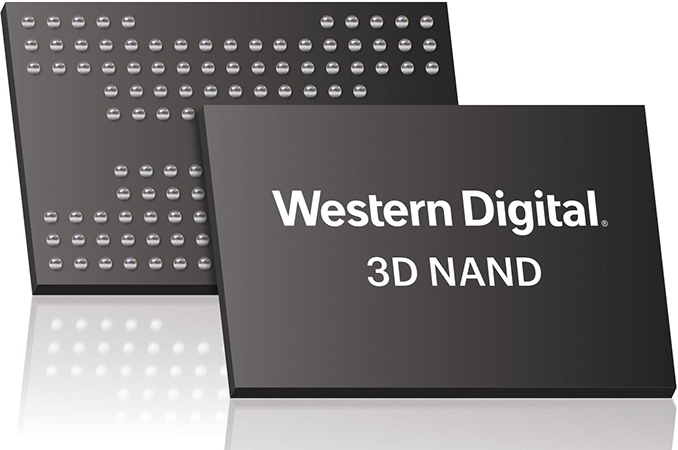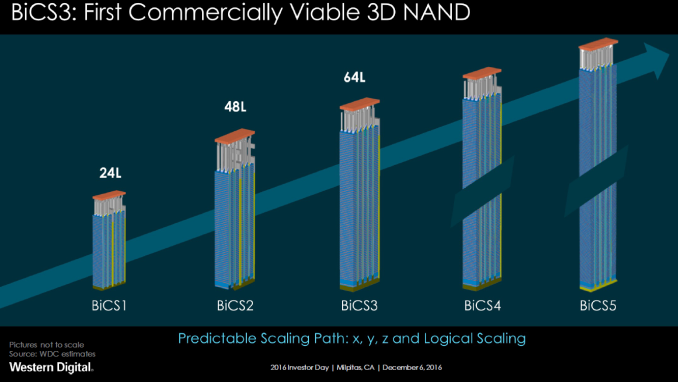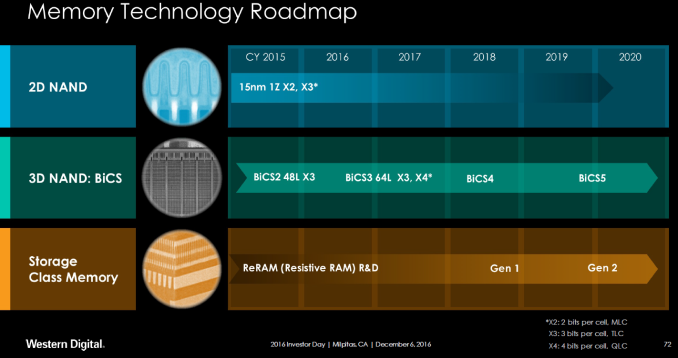Western Digital: 96-Layer 3D NAND Progressing Well, Shipping to Retail Customers
by Anton Shilov on May 29, 2018 8:00 AM EST
Western Digital this month said that it had started shipments of its fourth-generation BiCS 3D NAND memory to some of its customers. The company did not disclose details, but only said that the 96-layer 3D NAND memory is used for storage devices sold in retail, which usually means that it is used for inexpensive flash drives and/or memory cards. One of the important things about Western Digital’s BiCS4 memory is the manufacturer’s plan to build both TLC and QLC NAND using the technology.
Western Digital started production of its 96-layer BiCS4 NAND memory earlier this year and confirmed the beginning of the ramp up in late April during a conference call. At the J.P. Morgan Global Technology, Media and Communications conference in mid-May the company said that it had started to ship the said chips for revenue to its retail customers. Western Digital does not give any guidelines regarding the pace of the ramp up and the time when shipments of BICS4 exceed shipments of BICS3, but the fact that the ICs are used commercially is important.
“BiCS4, which is 96 layers, we have introduced that technology and we are shipping it primarily to our retail customers,” said Steve Milligan, CEO of Western Digital. “If you look to where we at from a yield curve perspective, because [BICS4] is not too mature, we are very pleased with where we are. Because once you get to a certain point, you can project where you are going to end at (based on cycles of learning, etc). So, the 96-layer technology is progressing quite well, we continue to increase output of that as we move to the rest of 2018, I am very thrilled and grateful for our strong 3D NAND execution.”
Western Digital’s (and Toshiba’s) BICS4 is a name for a family of 3D NAND flash devices featuring 96 active word lines (or layers). The lineup will include both TLC and QLC chips with capacities ranging from 256 Gb to 1 Tb. Based on Western Digital’s announcement from 2017, its first chips to use 96 word layers are 256 Gb 3D TLC NAND devices. After the manufacturer figures out how to produce 96-layer 3D NAND with sufficient yields, it will move on to higher-capacity 3D TLC and eventually 3D QLC chips with up to 1 Tb (128 GB) capacity.
Speaking of QLC, it is necessary to point out that last year Western Digital and Toshiba also announced 768 Gb BICS3 64-layer 3D QLC NAND memory and it is highly likely that such ICs will hit the market earlier than 96-layer QLC NAND. Nonetheless, QLC is a crucial part of Western Digital’s future plans.
Related Reading:
- Western Digital Announce BiCS4 3D NAND: 96 Layers, TLC & QLC, Up to 1 Tb per Chip
- Western Digital Announces Four Bit Per Cell 64-Layer 3D NAND Flash
- Toshiba's 768Gb 3D QLC NAND Flash Memory: Matching TLC at 1000 P/E Cycles?
- Intel And Micron Launch First QLC NAND: Micron 5210 ION Enterprise SATA SSD
Source: Western Digital













29 Comments
View All Comments
R0H1T - Tuesday, May 29, 2018 - link
A $110 for 120GB 3x point module would be big enough to serve as the only drive on a lot of mainstream systems; and is affordable enough to make dual partition enthusiast setups viable;Sorry but with the advent of QLC NAND, it's rated endurance (about ~1k best case) & the ensuing price war (China is betting big on NAND & DRAM) there's no way 3dXP can do all of that at an affordable price point. The scenario you're describing is a real oddball, basically you're thinking of someone who needs better speeds (also endurance?) than the best NVMe drives out there, yet doesn't need more than 120GB (or more) & is willing to pay a premium for a *slight increase in speeds. When you have flagship phones selling with 512GB storage (rumored with Note9) there's no way a mainstream laptop will look good with just 120GB on board.
*depending on usage the difference might be substantial, but still needs lots of compromise especially wrt storage space.
smilingcrow - Tuesday, May 29, 2018 - link
Q: What has the storage capacity of a phone, which is primarily for media files got to do with the capacity of a boot drive for Windows?A: Nothing.
R0H1T - Tuesday, May 29, 2018 - link
So you're gonna sell 120GB 3dXP on a mainstream laptop when 256~512GB SSD will be much cheaper, even for OEMs?Newsflash 256|512>>>120 especially for the masses!
surt - Tuesday, May 29, 2018 - link
You have to remember to show the masses your bar graph that shows your laptop is twice as fast** as the competition.** In contrived benchmark designed to show 3dx in its best light.
Dragonstongue - Tuesday, May 29, 2018 - link
the would be nice to, and if they can/able/willing to are very vastly different things.As far as I understood Xpoint compared to "standard" nand flash is quite expensive to produce, so likely they only have so much "wiggle room" are end up selling it "at cost" which the shareholders etc would be PISSED if they did this.
(kind of like HBM because of the interposer ends up being more expensive because there are extra steps required, more certification, more precision vs just printing off a "bare chip" that either makes the spec required or does not, which means can become flash for a USB stick, SSD, full blown NVME instead...I think IMO Xpoint likely is very similar ball game, is not widespread use (cannot be used everywhere) same as HBM cannot, so therefore higher than normal price along with more complexity behind the design as well)
If anything makers of NVME style likely are raking in handsome profits (on overall amounts sold) because they are "fast" not because they are likely any more expensive in comparison to the "old" style SSD...
they have went SLC-MLC-TLC-3d-3d Vnand-QLC (soon) etc, so the controllers are likely dirt cheap compared to what they once were AND they save quite a bit by not having to worry about heatsinks etc, just a bare pcb with a couple of chips on it (with u2/m2 vs standard 2.5mm SSD sata based)
watzupken - Wednesday, May 30, 2018 - link
3D XPoint is aptly named, i.e. no point for most users currently. I think it is a great SSD/RAM hybrid, but it is more SSD than RAM. The other unfortunate points are the price and the power draw. At low capacity, the power draw is pretty high, and the higher capacity ones draws too much power and is reaching the point where it needs a chunky if not active heatsink.peevee - Wednesday, May 30, 2018 - link
When it ends up as a 4GB cache for a 2TB QLC PCEex4 SSD, and they update the controller to take full advantage of the PCIex4, nobody would complain about 4GB/s speeds on most used files on a cheap (per TB) SSD.PeachNCream - Tuesday, May 29, 2018 - link
QLC is not a thrilling idea to me. The additional capacity is nice, but I was hoping we'd have a more stable/durable replacement for NAND before QLC approached mainstream sales. It really isn't even endurance that worries me at this point. It's data retention over time that makes me hesitate. I want to go pure solid state because I really like the performance benefits and resistance to shock and impact, but I don't feel like I should rely on SSDs for long term, powered-down storage. I've already dealt with data corruption using 2.5 inch SATA SSDs in external casings and have since switched back to platter-based drives for backups as a result. QLC seems perhaps more susceptible to loss than existing NAND, but I can't have a butterfingers moment and drop my backup HDD on the floor so I almost panic when I carry that external disk around.dgingeri - Tuesday, May 29, 2018 - link
I totally agree. I prefer quality over quantity. Hopefully, we'll get a technology soon that doesn't have the durability issues NAND has.ಬುಲ್ವಿಂಕಲ್ ಜೆ ಮೂಸ್ - Tuesday, May 29, 2018 - link
I must disagree dgingeri -"Quality" Nand does not appear to have a durability issue, only a data retention issue
I have been running Killdisk on a cheap 8GB Silicon Power thumb drive for almost 4 years now and it still works fine
I should reach my goal of 350 full wipes in the next few days
Killdisk has changed its website since I began testing the durability of Nand and they now proudly claim that Killdisk "IS" compatible with Flash memory
Durability does not seem to be the issue!